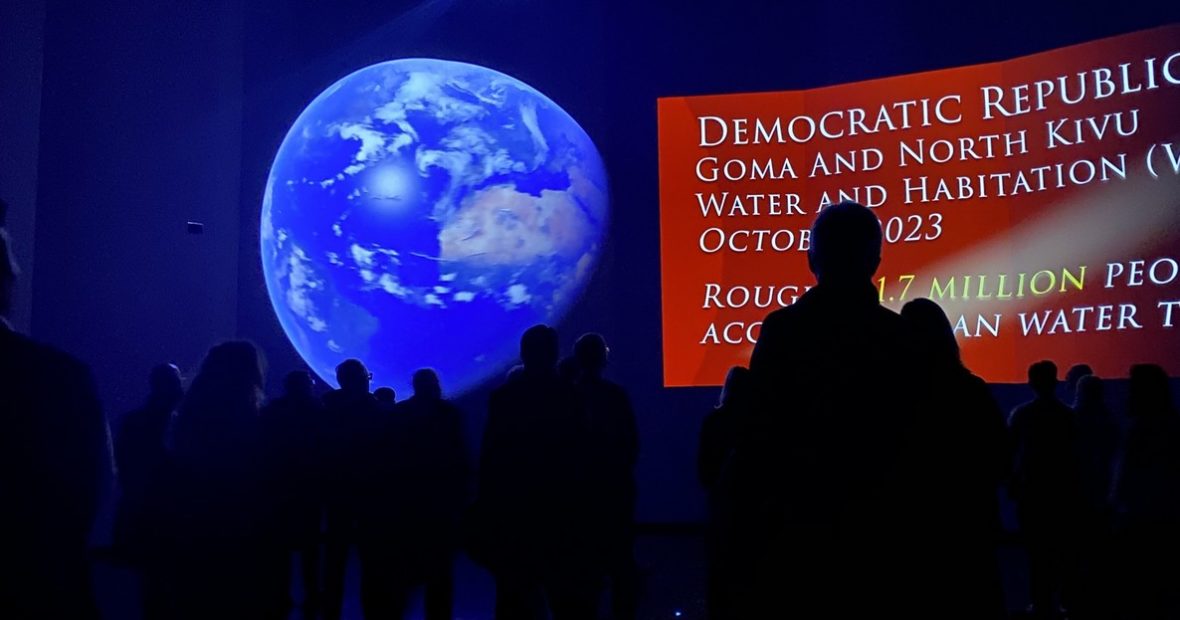What are donors looking for when it comes to supporting innovation at the ICRC? How important is it for them to partner with an innovative organization? What kind of solutions are catching their eye?
These are questions InspiRED put to participants at a recent event for Swiss private donors, showcasing some of the latest ICRC innovations.
Held in the International Red Cross and Red Crescent Museum, it featured initiatives well known to readers of this blog, such as the Mirror World, the Digital Dilemmas experience and climate action responses.
Addressing the event, ICRC Director-General Robert Mardini said that, with the nature of armed conflict constantly changing, the organization had “no other choice than to encourage staff to take risks, try new ideas, and to test, fail, learn”.
“It is absolutely critical, including in times of economic contraction, that we carve out a space for innovation to find new ways of working and responding to needs that can increase the impact of principled, neutral, impartial humanitarian action.”
Mardini cited several examples of where the ICRC is leveraging technology to ensure greater humanitarian impact.
Digital conflict
These include proposals for a digital emblem to enhance protection of critical services against cyber operations; the use of facial recognition to help put separated families back in touch; and the ICRC’s new Delegation for Cyberspace, which opened in Luxembourg in November last year, to test, inter alia, how the ICRC’s neutral, impartial humanitarian approach can apply in cyberspace.
“Armed conflict is reaching new frontiers, including cyberspace, where we need to transpose some of the ICRC’s practices and knowhow. We need to sharpen our ability to engage with actors carrying out cyberattacks or ransomware that can put in jeopardy not only civilian populations but also the delivery of humanitarian services.”
ICRC Director-General Robert Mardini
Anne de Riedmatten, the Canton of Geneva’s director of International Solidarity, said digitalized warfare was indeed an area where the humanitarian sector would be looking to the ICRC for guidance.
“In this domain, I think a lot of eyes are on the ICRC, as the guardian of IHL [international humanitarian law]. The ICRC’s understanding of the challenges will be essential, as will whatever innovative solutions you come up with,” she said.
“The consultations around the digital emblem are also exactly the kind of innovative discussions we need. The ICRC must be testing new ground.”
De Riedmatten added that it was imperative for any organization – and not just the ICRC – to support innovation to stay relevant and sustainable.
“Our globalized world is in constant change; so, for an organization like the ICRC, with the evolving nature of conflicts, you first need to be aware of the transformations and then have innovation help you come up with solutions to adapt,” she said.
“It’s essential because that’s the only way of ensuring that the assistance you provide to populations remains relevant to them.”
Artificial intelligence
Emily Turrettini, a Geneva-based journalist/blogger specializing in new technologies, echoed this, saying that traditional humanitarian responses – protecting people, feeding them, saving lives – needed to go “hand-in-hand with innovation”.
“Look at the impact that new technologies have had on communities around the world. Look at what the mobile phone has done for refugees, for example, enabling them to stay in touch with each other all over the world. They’re a lifesaver,” she said.
Turrettini believes large language models (LLMs) – a type of artificial intelligence – could be hugely beneficial to an organization like the ICRC, especially when it comes to analysing data.
The ICRC’s Innovation Team launched a research project earlier this year looking at how LLMs might improve the use and accessibility of information, while also assessing the risks.

Entering the ICRC’s digital twin via a VR headset. @Kristina Almonte/ICRC
Similarly, Nina Hoas, head of philanthropy advisory at LGT Private Banking, says philanthropists are increasingly seeking out initiatives that make organizations more efficient and effective.
“When it comes to the innovation space, the philanthropists we work with would likely be looking for initiatives involving new methodologies and new approaches that lead to systemic, sustainable change, whether it’s regarding climate action or humanitarian response,” she said.
Innovative financing solutions
Maximilian Martin, global head of philanthropy at Lombard Odier, a Swiss private bank, pointed to the development of innovative financing mechanisms as another area offering proven potential for public-private partnerships.
Lombard Odier was a co-sponsor of the world’s first Humanitarian Impact Bond (HIB), launched by the ICRC in 2017. The HIB was created to encourage social investment from the private sector to support the ICRC’s health programmes.
It has since funded three physical rehabilitation centres in Nigeria, the Democratic Republic of the Congo and Mali. More than 3,000 people with disabilities have benefited from their services.
Martin said: “With more than two billion people – or a quarter of the global population – living in fragile contexts, it’s clear that we will need more long-term innovative financing mechanisms to bridge the growing humanitarian funding gap in the future. New approaches that offer greater value for money and tap into sources of capital on top of development assistance represent the only logical way forward.”
The ICRC aims to mobilize a growing part of its income from innovative finance – in partnership with donors and investors – by 2030.
Nan Buzard, head of the ICRC’s Innovation Team, said the event showed the inherent value of regular exchanges with donors and other partners to better understand where they see potential for new ideas and engagement.
“They fully expect the ICRC to be pushing the boundaries of how we operate and to be constantly adapting to a changing world and changing needs. It is therefore vital for us to demonstrate a growing capacity to anticipate and test ideas across the organization in fields such as the climate and environmental crises, digitalization and data, energy transition and virtual reality for immersive training and advocacy,” she said.

